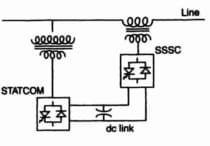1. Speed control by variation of field flux results in__________.
a. Variable power drive
b. Variable torque drive
c. Constant torque drive
d. Constant power drive
a. Variable torque operation
b. Randomly varying power operation
c. Constant torque operation
d. Constant power operation
3. Speed of an induction motor is controlled by injecting voltage into the rotor winding. Frequency of the injected voltage should be _________.
a. Slip frequency
b. Frequency corresponding to rotor speed
c. Frequency corresponding to required speed
d. Main frequency
4. The slip power recovery scheme is used in induction motor for speed control in the range__________.
a. Above synchronous speed
b. Below synchronous speed
c. Both above and below synchronous speed
d. None of the above
5. The electric braking system commonly employed in rolling mills, elevators and printing presses is ___________.
a. Regenerative
b. Dynamic
c. Rheostatic
d. Plugging
b. Cross-connection is better
c. Both are equally good
d. None of the two is required
7. Dynamic braking is employed to brake__________.
a. Reversing drive
b. Non-reversing drive
c. In both (a) and (b)
d. Either (a) or (b)
a. Saturation of flux at low
speed
b. Saturation of flux at high speed
a. Separately
b. Shunt
a. Regenerative braking
b. Plugging
a. Highest
b. Negligible
b. Separate dc source for
field excitation is available
c. It is a squirrel cage type
14. The motor enclosure used for collieries, chemical plants is _______.
a. Pipe ventilated type
b. Totally enclosed type
c. Splash proof type
d. Flame proof type
b. Totally enclosed fan cooled
type
c. Flame-proof type
b. Totally enclosed type
c. Protected type
d. Open type
17. Rotor of a motor is usually supported on_________.
a. Ball or roller bearing
b. Bush bearing
c. Thrust bearing
d. Any of the above
18. Ball-bearings are___________.
a. Costlier and noisy particularly at high motor speed
b. Used up to 75 kW motors
c. Of long life and low friction loss
d. All of the above
d. All of the above
c. Lack of or dirty lubricant
d. Loose coupling
21. Excessive motor vibration is caused by________.
a. Excessive brush tension
b. Bent shaft
c. Open armature coil
d. Worn bearings
d. Dirt on commutator
23. Intermittent sparking at the brushes of a dc motor may be caused due to_________.
a. Incorrect voltage
b. Loose coupling
c. Intermittent level
d. Open armature coil
b. Belt drive
c. Rope drive
b. Rope drive
c. Direct drive
d. Any of the above
26. In rotating electrical machines, the insulation temperature limit for class B type is________.
a. 105*C
b. 130*C
c. 150*C
d. 180*C
- Electric Drives and Motors MCQ Part-1
- Electric Drives and motors MCQ Part-2
- Electric Drives and Motors MCQ Part-4
- Electric Drives and Motors MCQ Part-5
- Electric Drives and Motors MCQ Part-6
- Electric Drives and Motors MCQ Part-7
- Electric Drives and Motors MCQ Part-8
- Electric Drives and Motors MCQ Part-9
- Electric Drives and Motors MCQ Part-10





0 Comments
If you have any doubt, feel free to ask.